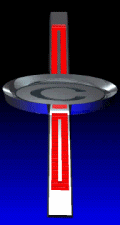|
A Technical History Frank Ecker
|
|||
|---|---|---|---|
|
The Corvair is a unique, controversial automobile that has
polarized our opinion. We have met through club activities, a wide
variety of Corvair enthusiast whose interest in the Corvair range
from the pure utility of it to those who tell you they are owners
of a thoroughbred grand touring machine. From the ranks of the
club, the comments on the Corvair are good, but ask a non-owner
and a verbal barrage will surely follow explaining the dangers of
owning, driving or riding in one. What kind of car can cause these
extreme feelings?
What follows is a short history of the Corvair, not complete by any means, but enough to assist you in an an explanation to a "layman". Design concepts unique to the Corvair, an American Built car, are many. General Motors worked with air cooled engines many a year prior to the Corvair with little success in their early endeavors, likewise, the engine location in the rear had been investigated in the late forties as an alternate location for small car applications. These two concepts were of interest to Ed Cole, initially Chevrolet's Chief Engineer and later it's General Manager. Serious development work was well underway in the mid-fifties on a rear engine air cooled small car. For engine and drive train evaluation, the early units were installed in Porsche body / chassis units. Concurrent with engine and drive train development were full sized mock-ups for the stylists to design a car without the massive grill work so popular during this period. ( I think J.C. Whitney offered one at $9.99 though, for the insecure owner who would miss a grill.) In the fall of 1957 the decision had been made to market a small car, still nameless, with an air cooled engine in the rear. A completely new plant was built in 1958 at Willow Run, Michigan designed for exclusive production of the Corvair. In comparison to other American built cars during the late fifties, the Corvair was a complicated car, definitely unorthodox by American standards. The flat six engine was the first one designed specially for high production automotive usage. The engine was much akin to those used in small private aircraft, initial designs were for an engine block of two pieces, which would have included the cylinder barrels with integral heads. If today's technology ( Reynolds Aluminum development work which made the Vega engine possible) had been available then, it might have been possible. This would have been closer to original design weight, unfortunately, the engine in its final form was about 25% heavier than planned. This amounted to a 3.5% more of the vehicle weight behind the rear wheels, not a good situation. There are many small details about the engine design which were unique approaches by the engineers at Chevrolet. One of the more controversial areas, was the cooling fan drive belt which twisted and turned more than what is normally expected. The early Corvairs tended to throw belts and this caused some buyer suspicion. This and a few other early problems definitely started the Corvair out on the wrong foot in the market place. In fact, Chevrolet decided right after the introduction of the Corvair to add the Chevy II to its product line as a conventional economy car for those buyers not willing to chance something different. It didn't take long for Chevrolet to offer factory installed handling packages, higher horsepower, four speed transmission, etc, to satisfy the demand for these items by a growing number of people recognizing the cars potential. In 1962 a turbocharged version, the industry's first, called the Spyder, was added and in 1963 it was offered in the convertible. The turbocharger was offered through 1966 and in its final form, developed 180 HP. Also between 1963 and 1964, the engine displacement was bumped up to 164 cu. in. To improve handling , the 1964 Corvair was given a transverse compensating spring to assist its rear suspension. This piece of hardware added fuel to the fire of many critics because it appeared to them as an admission of an inferior rear suspension on all pre 1964 Corvairs. In fact, 1964 was the year that the first court case came to trial regarding the Corvair's handling characteristics In 1965 Chevrolet made an attempt at satisfying the enthusiast with a new body style, a rear suspension resembling the Corvette's and a free breathing four single barrel carbureted 140-HP engine. This was also the year that the Mustang was introduced by Ford. Many within Chevrolet, especially the engineering staff, felt the Corvair could have matched the Mustang in overall performance and buyer appeal with the continued development. Instead, management chose another course, the development of the Camaro. A directive went out at this time stopping the development of the Corvair, except for that work necessary to meet federal safety standards. After a total of 1,710,010 units, production of the Corvair stopped on May 14th 1969. * reprinted from the Milwaukee Corvair Club Annual 1972 | |||


